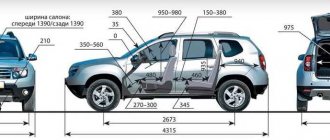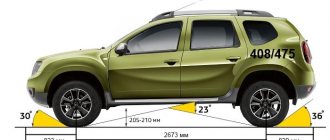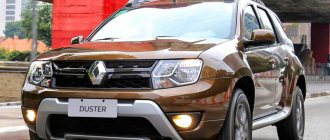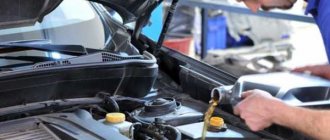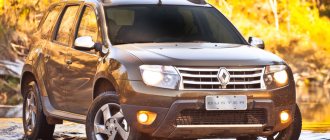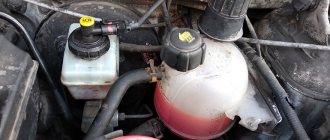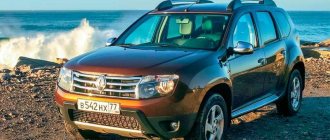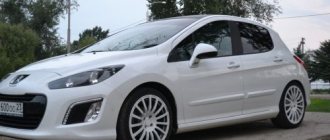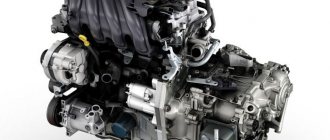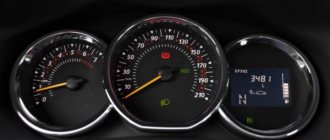The fuel consumption of Renault Duster depends both on the technical condition of the car and on the type of power unit, as well as operating conditions. Road conditions and ambient temperature have a big impact on efficiency. To reduce fuel costs, it is necessary to carry out regular maintenance, avoid sudden acceleration and downtime in traffic jams.
Renault Duster on a mountain road
passport details
These cars on the Russian market are found with an in-line 4-cylinder liquid-cooled engine:
- naturally aspirated 1.6-liter with spark ignition with a capacity of 102 and 114 hp. With. (parameters before restyling and after modernization);
- naturally aspirated gasoline with a capacity of 135 or 143 hp. With. with a volume of 2 l;
- 1.5 liter diesel engine with an adjustable turbocharger with a capacity of 90 or 109 hp. With. (depending on the year of manufacture).
1.5 l diesel engine
When using a compression ignition engine on the Duster, only all-wheel drive transmission with a 6-speed manual gearbox is available. Engines manufactured before 2015 have reduced power.
Transmission for Renault Duster
Later, the plant increased the boost pressure and adjusted the characteristics of the fuel supply equipment, which increased the efficiency of the power plant.
The efficiency characteristics declared by the manufacturer (in liters per 100 km) have not changed; the data is shown in the table.
| Power, l. With. | City | Highway at 90 km/h | In combined mode |
| 90/109 | 5,9 | 5,0 | 5,3 |
Petrol Renault Duster 1.6 l
The standard equipment of the cars included an engine that required operation on gasoline with an octane rating of at least 95 units. Until 2015, the K4M unit was used, borrowed from the Logan passenger car. After the modernization, the plant took into account customer dissatisfaction with the insufficient characteristics of the power plant and began to use the H4M engine (installed on some Nissan cars under the designation HR16DE) with increased power and torque. The manufacturer's declared fuel economy data in liters per 100 km are shown in the table.
| Power, l. With. | Transmission type | City mode | Highway conditions (at a speed of 85-90 km/h) | Combined cycle |
| 102 | Manual transmission, front-wheel drive | 9,8 | 6,5 | 7,6 |
| 102 | Manual transmission, all-wheel drive | 11,0 | 7,0 | 8,2 |
| 114 | Manual transmission, front drive wheels | 9,3 | 6,3 | 7,4 |
| 114 | Manual transmission, all-wheel drive | 9,1 | 6,8 | 7,6 |
Renault Duster 1.6l with HBO
The Russian Renault plant does not produce Duster cars with gas equipment. Owners modify crossovers in specialized centers and then make changes to the registration documents. The cylinder is installed in the niche for the spare wheel (on cars with front-wheel drive) or in the luggage compartment (4x4 versions). Dacia Duster cars are offered on the European market with a bi-fuel engine that consumes about 11 liters of gas in the urban cycle (the cars are not officially supplied to Russia).
Engine compartment of Renault Duster
2.0 with manual and automatic transmission
The 2.0L F4R engine is cast using an automatic variable valve timing system, which allows for increased torque at low speeds and saves fuel. Fuel consumption depends on the type of gearbox (hydromechanical 4-speed or 6-speed manual). The engine is only available with all-wheel drive. Factory fuel consumption parameters (in liters per 100 km) are shown in the table.
| Power, l. With. | Box type | City | Highway at 90 km/h | Mixed rhythm |
| 135 | Manual transmission | 10,3 | 6,5 | 7,8 |
| 135 | Automatic transmission | 11,3 | 7,2 | 8,7 |
| 143 | Manual transmission | 10,1 | 6,5 | 7,8 |
| 143 | Automatic transmission | 11,3 | 7,2 | 8,7 |
Engine 2.0
The car was also equipped with a more powerful engine – a 2.0 liter petrol unit with a capacity of 135 horsepower. In this configuration, the front-wheel drive version is equipped with only a six-speed manual transmission with a low-range first gear. After restyling in 2015, the engine was also redesigned, which now develops 143 horsepower. Also, the 4x2 version of the car disappeared from the configuration with such an engine. But a four-speed automatic has been added to the transmission choice. The fuel consumption of this engine is 7 liters on the highway and 11 in the city.
“I’ve been wanting to buy some kind of crossover for a long time. I've been saving for a couple of years and now I'm leaving the showroom in a brand new two-liter Duster that produces 143 horsepower, which is quite enough for quiet city trips around the city and to the countryside. Yes, the car may not be the most comfortable, but it overcomes both mud and snow well. In the summer I spend on average 9 liters of gasoline, but in winter my consumption is a little more. This is most likely due to the constantly running stove. But all the same, I’m completely satisfied with the car,” says Peter from Kursk about his choice.
“Never go shopping for a car with your wife. It was she who chose the Duster with an automatic transmission, and even with a 2.0 liter engine. I don’t argue that the car is quite comfortable and performs well in different weather and road conditions. For us, it starts easily even at -40. But the high fuel consumption does not suit me at all. In winter, we turn on the heating of everything possible and it comes out to 15 liters. In the summer, of course, it’s more modest, only 10, but this is clearly abnormal for this car,” wrote Evgeniy from Yakutsk.
Real fuel consumption rates for Renault Duster per 100 km
Car owners note that during operation it is difficult to obtain the results declared by the factory. Fuel consumption is on average 5-10% more than indicated in the passport. The reason lies in different driving conditions during testing and during everyday driving, as well as differences in the qualifications of ordinary drivers and professional factory testers.
- A 1.6 liter engine consumes at least 10 liters of gasoline in the city, turning on the air conditioning negatively affects the dynamics and leads to an increase in fuel costs by 1-1.5 liters per 100 km. On the highway at 90-100 km/h and partially loaded, you can fit in 7.2-7.4 liters of fuel (with the air conditioning turned off and uniform movement). An increase in speed to 120-130 km/h leads to an increase in consumption to 8.5-9.0 liters.
- A model with a diesel engine consumes from 5.5 to 7 liters of diesel fuel on the highway (depending on the load and pace of movement). In a calm city rhythm, the car needs 6 liters per 100 km. The use of air conditioning increases fuel costs by 0.3-0.5 liters (additional equipment has a slight effect on efficiency due to the increased torque available from low crankshaft speeds).
- The version with a 2-liter engine is the least economical in city mode. Consumption - from 11.5 liters of gasoline with an octane rating of 95 per 100 km. At the same time, the power reserve allows you to reduce fuel costs on the highway. At speeds of up to 100 km/h, a car with a manual transmission packs 6.8-6.9 liters. Using an air conditioner increases the parameter by 0.3-0.4 liters.
Real Renault Duster consumption rates are higher than those stated by the manufacturer
In traffic jams
When driving in heavy traffic, fuel consumption for cars with gasoline engines reaches 12-14 liters (models with a volume of 2.0 liters can burn up to 15-16 liters). The diesel modification consumes no more than 8 liters of fuel. When operating vehicles in off-road conditions, consumption depends on the average speed.
There have been cases where power plants burned up to 22-24 liters of gasoline per 100 km of travel (for example, when driving on muddy dirt roads).
Fuel consumption according to documents and efficiency of Renault Duster
We estimate the ground clearance of Renault Duster
All engines installed on Renault Duster diesel comply with environmental standards, including EURO-5 and have good efficiency. Leading engineers have developed several innovative systems to reduce fuel consumption and improve throttle response of power plants.
The turbocharged diesel engine has a supercharger with constantly variable geometry. This technology allows you to adjust the cross section directly at the turbine inlet at different loads and, accordingly, the engine has an optimal operating mode at any speed. In addition, it does not burn additional fuel at high or low speeds. The turbodiesel is equipped with common rail injection, which allows you to pump fuel at a sufficiently high pressure with possible regulation and change the timing of supply of any consumed fuel depending on the number of engine revolutions. Such innovations helped reduce real diesel fuel consumption by 100 kilometers:
- - on the highway - 5.0 liters;
- - in the city - 5.9 liters;
- - in the combined cycle - is 5.3 liters.
The gasoline power unit with a standard volume of 1.6 liters has a gas phase distribution system that optimizes fuel consumption. In addition, electro-hydraulic power steering also has a positive effect on fuel consumption. With its help, the fluid pressure directly in the amplifier is regulated not by the car’s power unit, but by a special electric motor. This function allows you to reduce fuel consumption and save up to one liter per 100 kilometers. This engine has a flow rate:
- - on the highway - 6.3 liters;
- - in the city - 9.3 liters;
- - in the combined cycle - is 7.6 liters.
The most powerful engine of the 2000 cubic centimeters is equipped with an ECO system, which, according to the developers, significantly reduces gasoline consumption, regulates engine power and reduces it depending on the situation. ECO mode is a software setting method and is activated using a regular button on the panel. With its help you can save up to 10% of fuel. Per 100 km consumption with this engine is:
- - on the highway - 6.5 liters;
- - in the city - 10.1 liters;
- - in the combined cycle - is 7.8 liters.
Factors affecting efficiency
The increase in fuel costs is influenced by various factors that can be divided into categories:
- general type (for example, driver qualifications or technical condition of the car);
- climatic (for example, slippery road surfaces lead to tire slipping and additional fuel costs).
Common reasons
General reasons affecting the efficiency of automobile internal combustion engines:
- Driving at uneven speeds, with frequent acceleration and gear shifting at high speeds.
- Loading the vehicle: As the weight increases, fuel consumption increases. Efficiency is negatively affected by operating a crossover with a trailer or carrying additional luggage on roof bars.
- Driving style: drivers with a dynamic driving style visit gas stations more often than colleagues who prefer measured driving. The difference in fuel consumption during quiet and sharp driving reaches 3-4 liters in city traffic and up to 2-3 liters when driving on the highway.
- Technical condition of the power unit and chassis. Worn parts lead to backlash and increased friction, which negatively affects efficiency. A clogged air filter, spark plugs with a broken gap between the electrodes, or oil with an incorrectly selected viscosity can increase fuel costs by 25-30% compared to factory values.
- Failures of fuel injection and exhaust gas purification system sensors and erroneous signals lead to enrichment or leanness of the air-fuel mixture and a drop in efficiency.
Driving Renault Duster on a flat road
Weather
Climatic phenomena affecting efficiency:
- Reduced air temperature leads to prolonged warm-up of the engine and enrichment of the mixture, which causes increased consumption of both gasoline and diesel fuel. In cold weather, the driver turns on the interior heating system, which also requires additional fuel consumption.
- In summer, turning on the air conditioning system increases consumption by 0.3-1.5 liters (depending on the volume and power of the engine and the load on the compressor).
- When moving against a strong wind, the engine burns additional fuel (from 0.3 to 0.7 liters per 100 km at speeds up to 90 km/h).
- In rainy weather, the driver turns on the air conditioning, which removes condensation from the inside of the windows. When the air temperature is below freezing, a layer of ice forms on the road surface, reducing dynamics and causing the drive wheels to slip.
About the consumption of Renault Duster 1.5 CDI, 1.6, 2.0
First appearing in 2009, the Renault Duster crossover, positioned as a compact urban crossover, immediately won a huge army of fans on the market. The reason for this popularity is that for its price this car offers many advantages that set it apart from a number of analogue models. Among them, Renault Duster has good comfort, dynamics and cross-country ability; fuel consumption also plays an important role.
The fuel consumption rate of this car is more than acceptable. In the small number of disadvantages that can be seen in the reviews of real owners, there are practically no complaints about excessive fuel consumption. You can drive it quite confidently off-road, but it feels great on the highway. After restyling in 2105, Duster became more attractive in appearance, its dynamics improved with the same fuel consumption indicators.
Fuel saving methods
The owner can reduce consumption in the following ways:
- change in movement style;
- maintaining good technical condition;
- reducing the load in the luggage compartment and interior.
The nuances of economical driving
To ensure minimum consumption on cars with a gasoline engine, you must:
- during dynamic acceleration, spin the crankshaft to 3800-4000 rpm and then switch to a higher gear;
- maintain the frequency at 2000-2200 rpm with uniform movement in top gear;
- if the load increases (for example, when driving uphill), switch the gearbox down, avoiding overloading the engine;
- Accelerate smoothly in city traffic, maintaining the speed within 2000-2500 rpm.
The supercharged diesel powertrain has a distinctive torque curve.
The peak is 240 N*m and is achieved at 1750 rpm (gasoline engines develop 156 or 195 N*m at a rotation speed of 4000 rpm). Speed switching is carried out at a reduced frequency. An on-board computer is used to control consumption.
